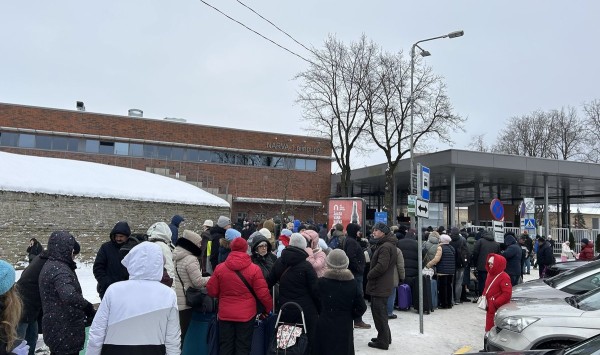
At first these people turned west and populated what now is Europe. But later migrants, specifically Slavic people, moved north pushing the sparsely populated Finno-Ugric people northward, either slaughtering them, or assimilating them. Only small groups still remain. Mr. Allas’ presentation ended with the observation that Christianity was spreading in Estonia already before the conquest by the Crusaders, Brethren of the Sword and Teutonic Knights. Since these armies were funded by North German merchants, it may be concluded that their conquest was less motivated by advancing the cause of their religion than to control the strategically important commercial routes to the East which ran through Estonia.
On another occasion former students of the Geislingen Estonian Gymnasium (GEG) and grade school gathered to renew acquaintances and discuss common issues. The meeting was led by Lembit Palm-Leis, who, despite the fact that the GEG-ers have no formal organization, is their spiritual leader. Incidentally, Geislingen is a city in south Germany which had a sizable Estonian Displaced Persons camp for five years following the end of the war. Gatherings such as this have become a tradition at not only West Coast Estonian Days but at KLENK and the ESTO festivals. Initially they included only anyone who attended GEG, but over time have included also teachers and those who attended the Geislingen Estonian grade-school, but emigrated before reaching the gymnasium. It was gratifying to notice that this time there were more of the last present than ever before.
Theatrical productions are always a central event at gatherings such as LEP. A touching drama was performed this year - “Migrant Homes,” which asks the question: what is a home, and where is this home? It was conceived, written, and performed by the theatrical group of the Vancouver Estonian community, named “Omamoodi Teater.” During the course of the play the audience was guided through the different paths which led the participants from Estonia to Vancouver. For some the trail started with escape in fishing boats to Sweden, followed subsequent by a voyage to Canada. The play had a certain sadness attached to the theme, because for those who escaped in 1944, the mantra was that they would return to Estonia when free again.

The audience was guided through the refugee days by skits supplemented with slides from personal collections of refugees: showing homes left behind, the boats with which they escaped, and their path to Canada. It underscored the difficulties the new immigrants faced and highlighted how they overcame those challenges through determination. The conclusion of the play was that Vancouver is now their home; their roots are too deep here to leave it now. It hinted that even the country they came from is no longer what they left behind. (Thomas Wolfe famously wrote, that “You can’t go home again.”) I was told that some people in Vancouver discouraged the performing of this play, - “why bring this topic up again?”. But this writer is grateful for the thoughtful play, and truly it was in the spirit of the West Coast Days, in addressing what is relevant to our community.
Art by Estonian artists could be enjoyed in a gallery that was open for the duration of the West-Coast Days. At the same time a very unique exhibit displayed 600 original letters, postcards, documents and telegraphs, that traced the events that led Estonia to independence. It included documents from 1800’s, which were in German or in Russian languages. The exhibit culminated in 1921 by which time the fully-independent Estonia had established its own language in all spheres of its national life. The exhibit gave a visual overview of what many of us learned in dry textbooks. The exhibit was compiled by Rein Vasara of Vancouver, using materials from private collections.
The foregoing was not meant to give a blow-by-blow account of the West Coast Estonian Days, but rather provide a commentary of the events, which the writer attended. There were other events scheduled for the younger generation to which this gray-haired writer was not drawn, but was glad that they were there to make these four days intergenerational, as the organizers had intended this to be. An example of a youth-oriented event was the social icebreaker party, which featured among others a band from Estonia - “Meie Mees”. The music seemed too loud. But then again, this seems to be a self-curing problem, - as we lose our hearing due to the high decibel levels, we will require more volume.
The gala ball was in contrast a very formal affair, with served dinner and music provided by an orchestra that was more to the liking to the older set. At this festive event the LEP flag was handed over to the Jüri Tint of Los Angeles, who, at a previously held meeting of the elders of the previous West Coast Estonian Days had been voted to lead the next LEP in two years.
The final day of the event was spent saying good byes and packing. Still, a fully attended indoor “picnic” allowed a last sustenance before setting off on the road back home. In these last hours of fellowship the attendees were entertained by Vancouver’s folk dancers and a unique choral group, Leelotajad, that sang Estonian songs of the past. And then we got into our cars and buses and left. We had been kept so busy the whole time, that very few of us took advantage of the curative waters of the fabled hot springs.
All in all, the West Coast Days of 2005 were a success. It validated the concept of merging local talent with “fresh blood” brought in from Estonia. The days brought acquaintances together, and in some case friends met friends who had not seen each other since leaving the refugee camps. It should be hoped that the success of this event would encourage the continuation of this tradition. Hope to see ya’ll at the next West Coast Days in Los Angles in the summer of 2007.

Teater


















